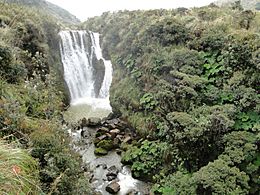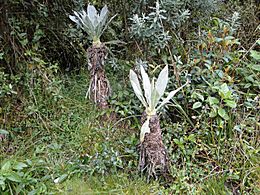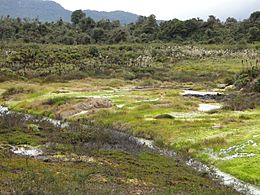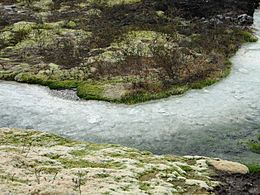Puracé National Natural Park facts for kids
Quick facts for kids El Parque Nacional Natural Puracé |
|
|---|---|
| Puracé National Natural Park | |
|
IUCN Category II (National Park)
|
|
 |
|
| Lua error in Module:Location_map at line 420: attempt to index field 'wikibase' (a nil value). | |
| Nearest city | Popayán, Colombia |
| Area | 830 km2 (320 sq mi) |
| Established | 1961 |
| Governing body | SINAP |
The Puracé National Natural Park (Spanish: Parque Nacional Natural Puracé) is a special place in Colombia. It's a national park located in the Andes Mountains, southeast of the city of Popayán. This park is famous for its active stratovolcano called Puracé. This volcano is one of the busiest volcanoes in Colombia!
Four of Colombia's most important rivers start their journey here. These are the Magdalena River, Cauca River, Japurá River, and Patía River. Imagine, all that water beginning in one amazing park!
Contents
About Puracé National Park
Puracé National Natural Park was created in 1961. It was the very first national park in the Cauca Department. For a while in the 1990s, a rebel group sometimes used parts of the park. But since 2002, the park has become much safer for visitors. This was thanks to efforts by the Colombian government.
Volcanoes and Mountains
The main active volcano in the park is Puracé. It stands tall at 4,580 metres (15,030 ft) above mean sea level. At the bottom of this volcano, you'll find the beautiful Paletará valley.
Besides Puracé, there are two even taller volcanoes nearby. These are Azúcar, which is about 5,000 m (16,000 ft) high, and Coconuco, at 4,600 m (15,100 ft). There are also four other volcanoes in the park. They are all very high, between 4,400 m (14,400 ft) and 4,500 m (14,800 ft).
How to Visit the Park
To get to Puracé National Park, you usually start from Popayán. Popayán is the capital city of the Cauca Department. You can reach Popayán by using the Pan-American Highway. This big road connects many parts of the country.
From Popayán, you take a road to the town of Puracé. This town is right at the foot of the volcano. The drive is about 44 km long and takes about an hour. The road is usually in good condition.
After Puracé town, you continue to a spot called "El Crucero." Just 1 km further, you'll find the lovely Pilimbalá area. This is a great place to relax and enjoy nature. It's in the northern part of the volcano. You can also reach the park from an old police base. This base is high up, at 4000 meters above sea level. You can drive there after passing the Puracé sulphur mines.
If you want to climb to the volcano's crater, it takes about 3 and a half hours from Pilimbalá. This is if you walk at a medium speed and the weather is good. If you start from the old military base, the climb is much shorter. It might only take about 1 and a half to 2 hours.
Climate in Puracé
The weather in Puracé National Park can be quite cool. During the day, the highest temperatures are usually between 14 and 16 °C (57 and 61 °F). At night, it gets very cold, often below freezing.
The park gets a lot of rain, about 2,500 millimetres (98 in) each year. However, the higher you go, the less rain there is. Frost is common above 3,000 m (9,800 ft). If you go above 4,200 m (13,800 ft), you might see frost almost every day!
Amazing Plants and Animals
Puracé National Park is home to many incredible plants and animals. It's a very important place for biodiversity.
Plant Life
You can find over 200 different kinds of orchids here. The park also protects some plants that are rare or threatened in Colombia. These include the Colombian Pine, the Andean Oak, and the tall Wax palm tree.
Animal Life
The park is a birdwatcher's paradise! Over 160 different kinds of birds live here. You'll see many hummingbirds, ducks, and powerful birds of prey.
Several interesting mammals also call Puracé home. Look out for the spectacled bear, the mountain tapir, and the cougar. You might even spot the tiny pudú, which is a small deer. The majestic Andean condor also lives here. The San Diego Zoo helped bring these amazing birds back to the park in the 1990s.
In the lower forests of the park, four types of primates live. These include the woolly monkey, howler monkey, gray-bellied night monkey, and tufted capuchin.
Gallery
Local Communities
The park's area is also home to indigenous communities. The Coconuco people live in the Pilimbalá sector. They offer comfortable places to stay and traditional food for visitors. There is also a settlement of the indigenous Guambiano people in the park area.
See also
 In Spanish: Parque nacional natural Puracé para niños
In Spanish: Parque nacional natural Puracé para niños







